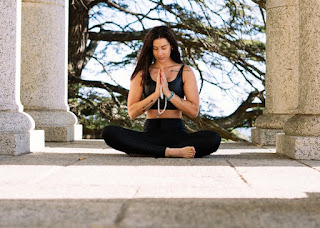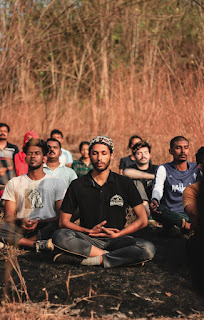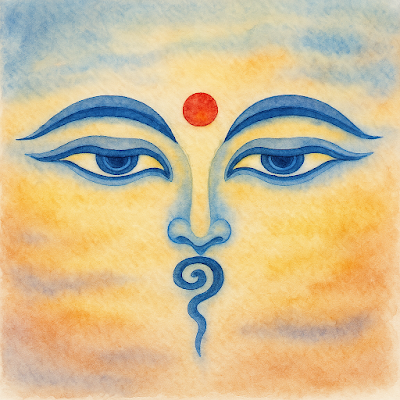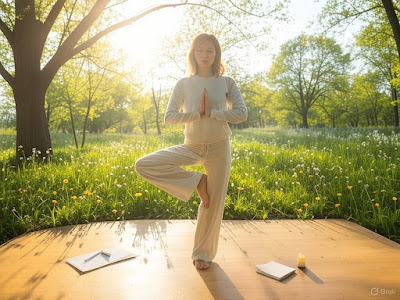Harnessing Inner Peace: A Comprehensive Guide to Meditation and Its Many Forms
In the relentless pace of modern life, where the noise of our daily routines often drowns out the voice of our inner selves, finding a sanctuary of peace becomes not just a luxury, but a necessity. “Harnessing Inner Peace: A Comprehensive Guide to Meditation and Its Many Forms” embarks on a journey to explore the ancient, yet ever-evolving practice of meditation—a journey that promises to unfold the layers of tranquility, clarity, and profound peace that lie within the reach of us all.
At its essence, meditation is the art of acquaintance with oneself. It’s a practice that transcends the boundaries of culture and time, offering a myriad of pathways to attain a state of inner calm and connectedness. From the silent whispers of mindfulness that teach us to embrace the present to the rhythmic chants of mantra meditation that guide us beyond the surface of thought, meditation serves as a bridge between the soul and the cosmos, the individual and the infinite.
In this guide, we delve into the heart of meditation, exploring its many forms and the unique benefits each brings to the seeker of peace. Whether you’re drawn to the gentle flow of movement-based meditations or the stillness of Zen, this comprehensive exploration is designed to illuminate the path that resonates with your spirit and lifestyle.

As we journey through the varied landscapes of meditation practices, we invite you to open your mind and heart to the possibilities that meditation offers. This guide is not just an introduction to the techniques but a beacon for those yearning to find peace in the chaos, depth in the superficial, and connection in the isolation. It is a testament to the transformative power of meditation in cultivating inner peace, enhancing well-being, and nurturing a profound sense of connectedness with the world.
In the relentless pace of modern life, where the noise of our daily routines often drowns out the voice of our inner selves, finding a sanctuary of peace becomes not just a luxury, but a necessity. “Harnessing Inner Peace: A Comprehensive Guide to Meditation and Its Many Forms” embarks on a journey to explore the ancient, yet ever-evolving practice of meditation—a journey that promises to unfold the layers of tranquility, clarity, and profound peace that lie within the reach of us all.
At its essence, meditation is the art of acquaintance with oneself. It’s a practice that transcends the boundaries of culture and time, offering a myriad of pathways to attain a state of inner calm and connectedness. From the silent whispers of mindfulness that teach us to embrace the present to the rhythmic chants of mantra meditation that guide us beyond the surface of thought, meditation serves as a bridge between the soul and the cosmos, the individual and the infinite.
In this guide, we delve into the heart of meditation, exploring its many forms and the unique benefits each brings to the seeker of peace. Whether you’re drawn to the gentle flow of movement-based meditations or the stillness of Zen, this comprehensive exploration is designed to illuminate the path that resonates with your spirit and lifestyle.
As we journey through the varied landscapes of meditation practices, we invite you to open your mind and heart to the possibilities that meditation offers. This guide is not just an introduction to the techniques but a beacon for those yearning to find peace in the chaos, depth in the superficial, and connection in the isolation. It is a testament to the transformative power of meditation in cultivating inner peace, enhancing well-being, and nurturing a profound sense of connectedness with the world.
Exploring Meditation Techniques
Meditation manifests in many forms, each with its unique focus, technique, and cultural origins. This diversity ensures that there is a meditation practice suited to every individual, regardless of lifestyle, personality, or spiritual beliefs. Let’s explore some of the most prominent meditation techniques, shedding light on their practices and the unique benefits they offer.
Mindfulness Meditation:
Rooted in Buddhist tradition, mindfulness meditation encourages practitioners to remain present and fully engaged with the moment. By observing thoughts, feelings, and sensations without judgment, individuals learn to witness the flow of experience with detachment and clarity, fostering a state of calm awareness.
Transcendental Meditation:
Transcendental Meditation (TM) involves the silent repetition of a mantra to settle the mind into a state of profound rest and relaxation. TM aims to transcend thought itself, accessing deeper levels of consciousness. This practice has been linked to reduced stress and anxiety, improved heart health, and enhanced cognitive function.
Guided Visualization:
This technique involves the mental visualization of calming and positive images or scenarios to relax the mind and body. Guided visualization can be particularly effective for those who find peace in imagery and prefer a more structured approach to meditation.
Loving-Kindness Meditation (Metta):
Metta meditation focuses on cultivating feelings of love, kindness, and compassion towards oneself and others. Practitioners repeat phrases or intentions that express goodwill, aiming to open the heart and foster a sense of connectedness and unconditional positivity.
Yoga and Movement-Based Meditation:
Incorporating physical postures and mindful breathing, yoga and other movement-based meditation practices, such as Tai Chi and Qigong, emphasize the connection between body and mind. These practices promote physical health, mental clarity, and emotional balance through fluid movements and focused attention.
Zen Meditation (Zazen):
Characterized by its simplicity, Zazen, or seated meditation, is a foundational practice in Zen Buddhism. Practitioners sit in a specific posture, focusing on their breath while observing thoughts and sensations without attachment, fostering a deep sense of inner peace and awareness.
Each of these techniques offers a pathway to inner peace, providing tools to navigate the complexities of life with greater calm, focus, and resilience. Whether you’re drawn to the quietude of Zen meditation or the active mindfulness of yoga, there’s a meditation practice to suit your needs and preferences.

Choosing the Right Meditation Practice for You
Embarking on a meditation journey can be both exciting and overwhelming given the plethora of techniques available. Finding the right practice is crucial for fostering a sustainable and fulfilling meditation experience. This section provides insights and tips to help you navigate the diverse landscape of meditation, ensuring you find a practice that resonates deeply with you.
Assess Your Goals and Preferences:
Begin by reflecting on what you hope to achieve through meditation. Are you seeking stress relief, emotional healing, increased focus, or spiritual growth? Different practices have unique strengths, so identifying your goals can help narrow your search. Additionally, consider your personality and lifestyle. If you prefer structure, a guided meditation or a practice with specific steps might appeal to you. If you value spontaneity, open-ended practices like mindfulness might be more fitting.
Experiment with Different Techniques:
Exploration is key to discovering what works best for you. Dedicate some time to experimenting with various meditation practices. Many local meditation centers, apps, and online platforms offer introductory sessions to different styles. Trying out several techniques can provide valuable insights into what feels most natural and beneficial for you.
Listen to Your Body and Mind:
Pay attention to how you feel during and after each meditation session. A suitable practice should leave you feeling refreshed, calm, and centered. If a particular technique causes discomfort or agitation, it might not be the right fit for you. Remember, meditation is a personal journey; what works for one person may not work for another.
Seek Guidance:
If you’re unsure where to start or if you’re struggling to find a practice that feels right, consider seeking guidance from experienced practitioners or meditation teachers. They can provide personalized recommendations and offer support as you explore different paths.
Be Patient and Open-Minded:
Finding the right meditation practice can take time. Approach the process with patience and an open mind. The right technique for you is the one that you look forward to practicing, that fits seamlessly into your daily life, and that brings you closer to your personal goals for meditation.
Embrace Flexibility:
Your meditation needs and preferences may evolve over time. Be open to exploring new practices or adapting your current practice as you grow and change. Meditation is a dynamic journey, not a static destination.
Incorporating Meditation into Your Daily Routine
Establishing a consistent meditation practice is key to reaping its full benefits. However, integrating new habits into a busy lifestyle can be challenging. Here are some tips to help you make meditation a regular part of your daily routine, ensuring that it enhances your life without becoming another source of stress.
Start Small and Be Realistic:
Begin with short sessions, even just a few minutes a day, and gradually increase the duration as you become more comfortable with the practice. It’s better to meditate for a short period consistently than to aim for longer sessions sporadically.
Choose a Specific Time and Place:
Consistency helps to build habits. Select a specific time for your meditation practice, such as in the morning to start your day with clarity, or in the evening to unwind. Also, designate a quiet, comfortable spot where you won’t be disturbed.
Make It a Non-Negotiable Part of Your Day:
Treat your meditation time as you would any important appointment. By prioritizing your meditation practice, you signal to yourself that it’s an essential part of your well-being, not just an optional activity.
Use Reminders and Tools:
Set reminders on your phone or use meditation apps that offer guided sessions and track your progress. These tools can provide structure and motivation, especially when you’re starting out or if your schedule varies day to day.
Incorporate Meditation into Daily Activities:
Meditation doesn’t always have to be a separate part of your day. Practice mindfulness during routine activities like walking, eating, or even while doing household chores. This approach can help you maintain a meditative mindset throughout the day.
Be Patient and Kind to Yourself:
Some days, meditation will feel easy and deeply rewarding; other days, it might feel challenging or tedious. Recognize that this is all part of the process. Be compassionate with yourself and remember that each session is a step toward greater peace and self-awareness.
Join a Community or Group:
Participating in a meditation group or community can provide support, motivation, and a sense of connection. Whether it’s an online forum or a local meditation center, being part of a community can enrich your practice and offer valuable insights and encouragement.

Conclusion: The Path to Inner Peace Through Meditation
As we conclude our journey through the expansive landscape of meditation, it’s clear that this ancient practice offers a profound pathway to inner peace, personal transformation, and enhanced well-being. From the quiet solitude of mindfulness to the harmonious movements of yoga, each form of meditation invites us into deeper communion with ourselves and the world around us.
A Personal Journey of Discovery:
Meditation is more than a practice; it’s a journey of discovery—a journey that has no end, only deeper layers of understanding and connection. As you explore the various techniques and traditions outlined in this guide, remember that the best practice is the one that resonates with you, bringing you closer to the tranquility and clarity you seek.
Building a Foundation for Well-being:
Incorporating meditation into your daily routine can transform it from a mere activity into a cornerstone of your well-being. By setting aside time to meditate, you’re not just pausing to quiet your mind; you’re investing in your health, cultivating resilience, and opening yourself to the richness of the present moment.
A Ripple Effect on Society:
The benefits of meditation extend beyond the individual, touching the lives of those around us. As we each find our peace, we contribute to a more compassionate, understanding, and peaceful world. The collective power of individual tranquility has the potential to transform societies, bridging divides and fostering a sense of shared humanity.
An Invitation to Begin:
Whether you’re new to meditation or seeking to deepen your practice, this guide is an invitation to begin. With each breath and each moment of awareness, you’re taking steps on the path to inner peace—a path that is uniquely yours, yet connects you to the vast tapestry of life.
In embracing the art and science of meditation, we open ourselves to a world of possibilities. May this guide be your companion on a journey that brings peace, joy, and balance into your life and into the hearts of all who embark on this timeless practice.





